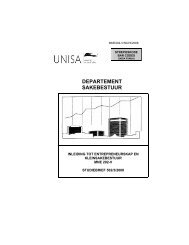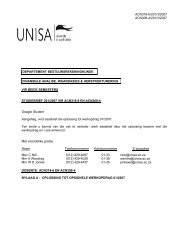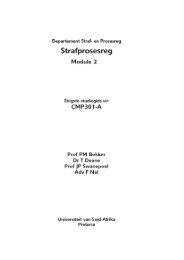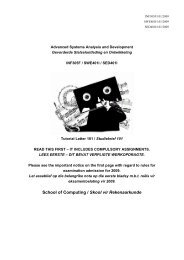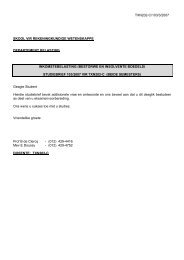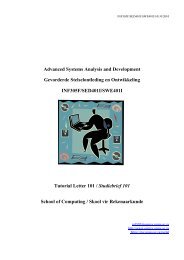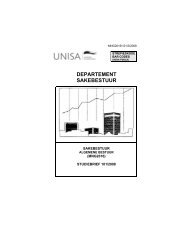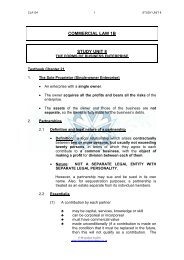key to the study guide - Name
key to the study guide - Name
key to the study guide - Name
You also want an ePaper? Increase the reach of your titles
YUMPU automatically turns print PDFs into web optimized ePapers that Google loves.
FEEDBACK<br />
(1) The requirement that <strong>the</strong> prescribed formalities for <strong>the</strong> conclusion of a<br />
marriage should be complied with was at issue in this case.<br />
(2) The applicant in this case applied for an order declaring his marriage<br />
null and void because <strong>the</strong> wedding had taken place, in conflict with<br />
section 29(2) of <strong>the</strong> Marriage Act 25 of 1961, in <strong>the</strong> front garden of a<br />
dwelling house and not in <strong>the</strong> house.<br />
(3) Section 29(2) of <strong>the</strong> Marriage Act 25 of 1961.<br />
(4) Section 29(2) provides that a marriage shall be solemnised in a church<br />
or o<strong>the</strong>r building which is used for religious services, or in a public<br />
office or private dwelling house with open doors and in <strong>the</strong> presence of<br />
<strong>the</strong> parties <strong>the</strong>mselves, and at least two competent witnesses.<br />
(5) The object of <strong>the</strong> provision is <strong>to</strong> avoid clandestine marriages.<br />
(6) This decision is <strong>to</strong> be welcomed since only a material defect ought <strong>to</strong><br />
render a marriage void ab initio.<br />
Registration The registration of a marriage is discussed on page 39 of <strong>the</strong> textbook. You<br />
only have <strong>to</strong> know that <strong>the</strong> marriage register has <strong>to</strong> be signed by <strong>the</strong><br />
parties <strong>to</strong> <strong>the</strong> marriage, two witnesses and <strong>the</strong> marriage officer. Should this<br />
not be done, <strong>the</strong> marriage is not invalid.<br />
Consanguinity<br />
Affinity<br />
Blood relatives in<br />
direct line<br />
Ascendants<br />
Descendants<br />
Blood relatives in<br />
collateral line<br />
Problem area<br />
Here we shall look at <strong>the</strong> degrees of relationship which make a marriage<br />
unlawful, since students sometimes find it difficult <strong>to</strong> understand this<br />
section of <strong>the</strong> work. What we have <strong>to</strong> say below is merely an attempt <strong>to</strong><br />
help you <strong>to</strong> understand what is contained in your prescribed textbook on<br />
pages 32±34 under <strong>the</strong> heading ``3.4.4 Persons who are within <strong>the</strong><br />
prohibited degrees of relationship''. Our discussion does not replace<br />
those pages, which you must <strong>study</strong>.<br />
1 Explanation of concepts<br />
It was pointed out above that certain people may not marry each o<strong>the</strong>r<br />
because <strong>the</strong>y are <strong>to</strong>o closely related. These people fall in<strong>to</strong> two categories:<br />
those who are related by blood (this is known as blood relationship or<br />
consanguinity) and those who are related by marriage (this is known as<br />
affinity). The relationship can be in <strong>the</strong> direct line or in <strong>the</strong> collateral line.<br />
Persons who are blood relatives in <strong>the</strong> direct line are ascendants and<br />
descendants of each o<strong>the</strong>r. (Your ascendants are your forebears or<br />
ances<strong>to</strong>rs, that is, your parents, grandparents, great-grandparents, and<br />
so on. Your descendants are those born of you and your children and <strong>the</strong>ir<br />
children, and so on.) Persons who are blood relatives in <strong>the</strong> collateral line<br />
are not ascendants and descendants but never<strong>the</strong>less have one or more<br />
common ances<strong>to</strong>r. The common ances<strong>to</strong>r is a person <strong>to</strong> whom both<br />
49



